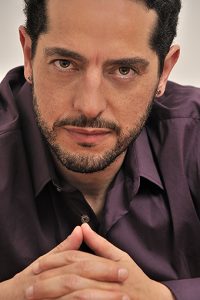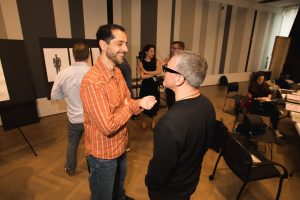Director of New Work and Dramaturgy Bobby Kennedy speaks with the man behind the creation, direction and continuation of Quixote: On the Conquest of Self, Claudio Valdés Kuri, about his lifetime spent imagining in the Mexican theatre scene.

Claudio Valdés Kuri
Bobby Kennedy: How did you first become interested in theatre? Was there a lot of interaction with the arts in your childhood?
Claudio Valdés Kuri: My father died when I was not even a year old. He was an architect and painter and left us a house full of art, books, and a lot of drawing material. My mother is also a painter. I grew up with all of these things around me. My first memories are of making theatre. When I was two years old, I remember being onstage and crying because I was too shy to be there. I’ve been told I used to direct theatre with my cousins and my friends when I was very young. I wanted to study piano but we didn’t have the means to have one at home. A neighbor, a great Austrian musician who had a music academy knew about that. She taught me and let me use the pianos at the school to study. Later on, the music academy created a theatre group to help educate children through theatre. I was a part of that group from the age of 10 until I was 27 years old. At the same time I was making theatre, I was also making music. At the age of 19, I founded a vocal ensemble dedicated to reviving early Mexican Baroque music. I obtained my degree in cinema. I started making documentary films, but I realized that my imagination goes to the stage. After being an actor, musician and film director, I decided just to direct theatre. My approach to the theatre has changed throughout my life. First it was simply a tool for growing up, then it was the medium through which I could get in contact with others, and then it was a way for me to find a place within my community. I think that initially artists turn to their work as a first step to be accepted. But ideally, the artist could overcome this need in order to work for other wider means that benefit a larger range of people other than himself.
BK: What is the theatre scene like in Mexico?
CVK: Very large, really active, and with a lot of different approaches. In the second half of the twentieth century we had great support from the government. They provided almost 80% of the funding. This was a very positive condition for the development of laboratory and experimental theatre because one wasn’t dependent on ticket sales. In the last decade this has changed completely because there is less support from the government. In these new circumstances I have had to find new ways to continue producing. I have told myself, “just trust, something has to happen” and it has been! This experience with Writers Theatre is a part of this opening towards new ways of creating art and it signals a different condition in which I have to direct in other countries instead of going with my company from Mexico to those places.
BK: Can you tell me about the founding of your theatre company Teatro de Ciertos Habitantes?
CVK: We started with a project, not as a company. The play was Becket or The Honor of God by Jean Anouilh. I read it and was completely absorbed. It was in my mind for thirteen years; I first encountered it when I was 19 and I was 33 when I directed it. I staged it in a staircase in an old convent. We were rehearsing for one year, my actors and myself, without any support. Unexpectedly, this staging became very successful and it marked the beginning of our international career with presentations of our works throughout the most important venues in five continents.
We have done just ten plays in twenty years because our way of producing requires long periods for reflection and research before each play. I make the actors be a part of the research. I call them co-creators because I am not just telling them what to do. They are searching with me. At first, I don’t give them a text. Usually, I don’t let them know where we are going in order to avoid preconceptions. I often look to expand the rehearsal studio into other places. Sometimes I let the actors take their character to a park, or a bowling alley, or a pool. The basis of my technique is to create experiences with the interpreters through which they can find answers to my open questions. This allows us to discover many more solutions than the ones I could have found on my own. I write all of the findings down and put them in a certain order. From there the staging takes shape.
BK: How did you first bring your work to Chicago and meet Henry Godinez?
CVK: I met Henry for the first time at Goodman Theatre when he brought our show, The Grey Automobile, to the Latino Theatre Festival in 2003. I saw him again when I came back to Chicago to present Monsters and Prodigies in 2009 and El Gallo in 2011 at the Museum of Contemporary Art. In 2014, we found each other again in Tijuana for the Theatre Communications Group event where I also met Michael Halberstam. I invited Michael to Mexico City but I wasn’t sure he would come. He told me he didn’t have a theatre that programs international work, so the last person I thought would come to Mexico was Michael. But surprisingly he came. He saw one performance of our play Life is a Dream, and I think it moved him because he came back the next day to the theatre to see it again. From here we had the ideal conditions to bring into fruition the years long desire that Henry and I had to work together on a project. I found the perfect character for Henry to showcase his great inner strength and enormous artistic ability in Don Quixote. In addition, we had a man with great vision, Michael, willing to be a part of our adventure and making our yearnings a reality at Writers Theatre.

Claudio Valdés Kuri and Michael Halberstam. Photo by Joe Mazza.
BK: What was your history with the original book and how did you decide to adapt it into a play?
CVK: My relationship with Don Quixote of La Mancha is the same as for almost all Mexicans. You know him very well without having read the book. I read some parts of the book for school. Quixote in Mexico is everywhere: there are statues, toys, cartoons, everything. It is the same as in Spain and the rest of Latin America. We wrote in the play that there is not a house or a library or school that does not have a copy of Quixote, and that’s true. As a matter of fact, the most important festival in Latin America is devoted to his author, Miguel de Cervantes: the Festival Internacional Cervantino in Guanajuato, Mexico. 2016 was the 400th anniversary of Cervantes’ death, so they made a big celebration. The director of the festival commissioned me to do this play, and I read the book in its entirety for the first time. I thanked him for making me read this masterpiece that is more than a book; it’s really a touch of life. It is an extremely entertaining book, but it is much more than that. It changed me. It’s my companion. He’s near me all the time. To create this new script, I decided to work with Mónica Hoth, a renowned Mexican playwright who is an expert on theatre for young audiences. I placed a challenge upon her: to write a Quixote that was directed towards all audiences.
BK: Where does Quixote fit in your evolution as a theatre artist?
CVK: After many years in this profession, theatre is now, for me, a way of being of service to others. With the last few projects I have taken on, my main goal has been to find ways of being useful for the spectators. My previous projects were capricious because my only concern was if I liked them. Now I am looking for ways to position myself so that I can be useful to my environment and the audience that comes to see the plays. I’m not thinking about a specific community because my productions are geared towards global audiences. In this way, Quixote is the character to embody my intentions. Don Quixote is the greatest example, and an inspiring model to follow, of a human being in the service of humankind. I don’t know if I would have done a Quixote before or not, but now it fits perfectly because he is that challenging inspiration.


No comments yet.